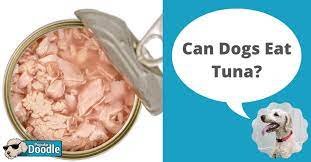
Considering tuna as part of your dog’s diet? Tuna, a popular seafood known for its nutritional value, is occasionally fed to dogs by conscientious pet owners seeking to diversify their pet’s meals. Many are drawn to tuna for its high protein content, essential for muscle development and maintenance in dogs. Moreover, the omega-3 fatty acids found in tuna can contribute to healthy skin, a shiny coat, and support joint health, making it a desirable addition to their diet.
However, ensuring safe quantities is crucial when introducing tuna to your dog’s meals. While tuna offers nutritional benefits, such as vitamins and minerals, it’s important to be mindful of potential risks, including mercury levels and high sodium content, especially in canned varieties. Understanding these factors helps pet owners make informed decisions about incorporating tuna into their dog’s diet responsibly, ensuring their health and well-being are prioritized.So now,let’s explore that-can dogs eat tuna?
Nutritional Benefits of Tuna
Tuna offers a range of nutritional benefits that can contribute positively to a dog’s diet, supporting various aspects of their health and well-being:
High Protein Content for Muscle Maintenance
- Muscle Development: Tuna is rich in high-quality protein, essential for building and maintaining strong muscles.
- Amino Acids: Provides essential amino acids necessary for muscle repair and growth.
Omega-3 Fatty Acids for Healthy Skin and Coat
- Skin Health: Omega-3 fatty acids found in tuna help maintain healthy skin by reducing inflammation and supporting hydration.
- Coat Condition: Contributes to a shiny, lustrous coat, reducing dryness and itching.
Essential Vitamins and Minerals like B Vitamins and Selenium
- B Vitamins: Important for energy metabolism, nerve function, and maintaining healthy skin and coat.
- Selenium: Acts as an antioxidant, protecting cells from damage and supporting immune function.
- Other Minerals: Provides essential nutrients like magnesium and potassium, crucial for overall health and vitality.
Low in Saturated Fats, Promoting Heart Health
- Heart Function: Tuna’s low saturated fat content helps maintain healthy cholesterol levels and supports cardiovascular health.
- Weight Management: Being low in fat can aid in weight management and prevent obesity-related health issues in dogs.
Incorporating tuna into your dog’s diet, while considering moderation and potential risks such as mercury content in larger fish, can provide valuable nutritional benefits. Always ensure tuna is prepared and served safely, and consult with a veterinarian to tailor your dog’s diet to their specific needs and health requirements.
Risks Associated with Over consumption
Over consumption of tuna in dogs can lead to several health risks that pet owners should be aware of:
- Mercury Toxicity: Accumulation and Effects on Health
- Bio chemical: Larger fish like tuna can accumulate mercury over time due to environmental exposure.
- Health Effects: Chronic exposure to mercury can lead to neurological issues, affecting the nervous system and cognitive function in dogs.
High Sodium Levels in Canned Tuna
- Sodium Content: Canned tuna, especially those packed in brine or with added salt, can contain high levels of sodium.
- Health Risks: Excessive sodium intake can lead to dehydration, electrolyte imbalances, and potentially exacerbate kidney issues in dogs.
Risk of Parasitic Infections from Raw or Undercooked Tuna
- Parasites: Raw or under cooked tuna can harbor parasites such as roundworms and tapeworms.
- Health Implications: These parasites can cause gastrointestinal issues and other health problems in dogs if ingested.
Potential for Allergic Reactions
- Allergies: Some dogs may be allergic to proteins in tuna or other components of the fish.
- Symptoms: Allergic reactions can manifest as itching, swelling (especially around the face and throat), digestive upset (vomiting, diarrhea), or respiratory issues.
Understanding these risks associated with over consumption of tuna can help pet owners make informed decisions about their dog’s diet. It’s important to monitor tuna intake, choose safer preparation methods, and consult with a veterinarian to ensure balanced nutrition and minimize potential health hazards.
Guidelines for Safe Tuna Consumption
Feeding tuna to dogs can be a nutritious addition to their diet when done responsibly and with consideration of their specific needs. This guide outlines guidelines for safe tuna consumption, covering recommended types, serving sizes, frequency of feeding, and safe cooking methods to ensure your dog’s health and well-being.
- Recommended Types of Tuna: Fresh or Canned (in Water, No Added Salt)
- Fresh Tuna: Opt for fresh tuna when possible, as it typically contains fewer additives and lower sodium levels compared to canned varieties.
- Canned Tuna: If using canned tuna, select varieties packed in water with no added salt or seasonings to reduce sodium intake.
Serving Size Recommendations Based on Dog’s Weight and Breed
Proper portion control helps prevent overconsumption and maintains nutritional balance:
- Small Dogs (up to 20 lbs): Limit tuna to 1-2 tablespoons per serving.
- Medium Dogs (20-50 lbs): Offer up to 1/4 cup of tuna per serving.
- Large Dogs (50+ lbs): They can have up to 1/3 cup of tuna per serving.
- Adjust serving sizes based on your dog’s individual weight, activity level, and dietary needs.
- Frequency of Feeding: Occasional Treat vs. Regular Diet
Moderation is key when incorporating tuna into your dog’s diet:
- Occasional Treat: Treat tuna as an occasional addition or special treat, rather than a regular meal, to avoid over-reliance on fish protein.
- Balanced Diet: Ensure tuna treats are balanced with your dog’s regular food to maintain overall nutritional adequacy.
Cooking Methods to Ensure Safety
Proper preparation ensures tuna is safe for your dog to consume:
- Cook Thoroughly: If feeding fresh tuna, ensure it is cooked thoroughly to eliminate potential parasites and reduce the risk of bacterial contamination.
- Avoid Seasonings: Do not add salt, spices, or other seasonings that may be harmful to dogs’ digestive systems.
By following these guidelines, pet owners can safely incorporate tuna into their dog’s diet as a nutritious and enjoyable addition, while prioritizing their health and well-being. Regular consultation with a veterinarian can provide personalized advice based on your dog’s specific health needs and dietary requirements.
Recognizing Signs of Overconsumption
While tuna can be a beneficial addition to a dog’s diet when given in moderation, over consumption can lead to various health concerns. It’s important for pet owners to be aware of the signs and symptoms indicating potential over consumption of tuna. This guide highlights how to recognize these signs, ranging from mercury poisoning and sodium overdose to allergic reactions and long-term effects.
Symptoms of Mercury Poisoning
Mercury is a toxic metal that can accumulate in fish like tuna, especially larger and older fish:
- Lethargy: Unusual tiredness or lack of energy in your dog.
- Vomiting: Persistent or recurrent episodes of vomiting.
- Loss of Coordination: Difficulty maintaining balance or coordinating movements.
Indicators of Sodium Overdose
Excessive sodium intake, often from canned tuna with added salt, can lead to health issues in dogs:
- Excessive Thirst: Constantly seeking water and drinking more than usual.
- Frequent Urination: Needing to urinate more frequently than normal.
- Diarrhea: Loose or watery stools, potentially due to electrolyte imbalance.
Signs of Allergic Reactions
Some dogs may be allergic to proteins found in tuna or other components of the fish:
- Itching: Persistent scratching or skin irritation.
- Swelling: Particularly around the face, lips, tongue, or throat.
- Gastrointestinal Upset: Symptoms may include vomiting, diarrhea, or abdominal discomfort.
Long-Term Effects of Regular Over consumption
Consistent over consumption of tuna can lead to cumulative health issues over time:
- Mercury Accumulation: Chronic exposure to mercury can affect the nervous system, leading to cognitive and developmental issues, especially in puppies, senior dogs, and those with compromised immune systems.
- Sodium-related Health Problems: High sodium levels can contribute to hypertension, kidney problems, and exacerbate heart disease.
- Nutritional Imbalances: Overreliance on tuna can lead to deficiencies in other essential nutrients not adequately provided by fish alone.
Recognizing these signs and symptoms allows dog owners to monitor their pets closely and seek veterinary advice if any concerns arise. By being vigilant and mindful of their dog’s diet, owners can ensure that tuna and other foods are safely incorporated into their pet’s nutrition plan, promoting health and well-being while minimizing potential health risks.
Alternatives and Expert Recommendations
When considering the best diet for your dog, it’s important to weigh the benefits and risks of various food choices. While tuna can offer nutritional advantages, exploring safer alternatives and maintaining a balanced diet are essential for your pet’s overall health and well-being. This guide explores alternative fish options, stresses the importance of dietary variety, emphasizes the value of veterinary guidance, and summarizes key considerations for safe and healthy feeding practices.
Safer Fish Options: Salmon, Sardines, Whitefish
When choosing fish for your dog’s diet, consider these alternatives to tuna:
- Salmon: Rich in omega-3 fatty acids that support heart health and promote a shiny coat.
- Sardines: High in omega-3s and low in contaminants, providing essential nutrients.
- Whitefish (e.g., cod, haddock): Low in fat and a good source of lean protein, suitable for dogs with sensitive stomachs.
Importance of a Balanced and Varied Diet
A diverse diet ensures your dog receives a wide range of nutrients:
- Nutritional Balance: Rotate between different protein sources, including fish, to provide essential vitamins and minerals.
- Avoid Overdependence: Prevent overreliance on any single food item to mitigate potential nutritional deficiencies.
Consulting a Veterinarian for Personalized Feeding Advice
Veterinary input is crucial for tailoring your dog’s diet to their specific needs:
- Health Assessment: Veterinarians can evaluate your dog’s health status, allergies, and dietary requirements.
- Customized Recommendations: Receive personalized advice on appropriate serving sizes, feeding frequency, and specific dietary adjustments.
- Summary of Benefits and Precautions: Ensuring Safe and Healthy Feeding Practices
Understanding the benefits and precautions associated with feeding fish to dogs promotes responsible pet care:
- Benefits: Fish provide high-quality protein, omega-3 fatty acids for skin and coat health, and essential vitamins and minerals.
- Precautions: Be mindful of mercury levels, potential allergens, and the importance of moderation in feeding fish.
- Safe Practices: Choose fish wisely, cook if necessary, monitor for adverse reactions, and consult with a veterinarian for guidance.
By following these guidelines and seeking professional advice, you can ensure that your dog receives a nutritious and balanced diet, promoting their overall health and longevity. Incorporating safe and healthy feeding practices ensures that your pet thrives with optimal nutrition and minimal health risks associated with their diet.




